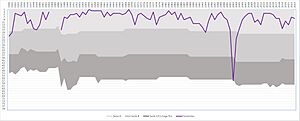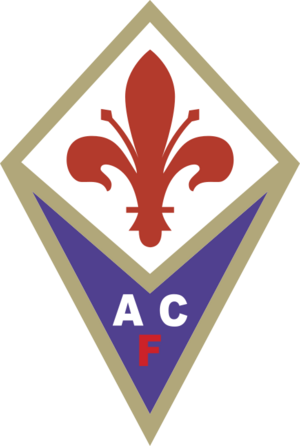ACF Fiorentina facts for kids
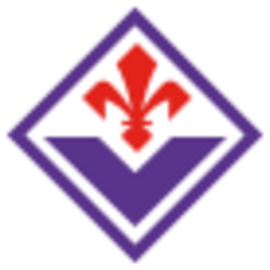 |
|||
| Full name | ACF Fiorentina S.r.l. | ||
|---|---|---|---|
| Nickname(s) | I Viola (The Purples / The Violets) I Gigliati (The Lilies) |
||
| Founded | 29 August 1926, as Associazione Calcio Fiorentina 1 August 2002, as Florentia Viola then ACF Fiorentina |
||
| Ground | Stadio Artemio Franchi | ||
| Capacity | 43,147 | ||
| Owner | New ACF Fiorentina S.r.l. | ||
| Head coach | Stefano Pioli | ||
| League | Serie A | ||
| 2018–19 | Serie A, 16th of 20 | ||
|
|
|||
ACF Fiorentina, often called Fiorentina, is a professional football club from Florence, Tuscany, Italy. The club was first created in August 1926. The current club was restarted in August 2002 after facing serious financial problems. Fiorentina has played in Italy's top football league, Serie A, for most of its history. Only four other clubs have played more seasons in Serie A.
Fiorentina has won the Italian league title twice, in 1955–56 and 1968–69. They have also won six Coppa Italia trophies and one Supercoppa Italiana. In European competitions, Fiorentina won the UEFA Cup Winners' Cup in 1960–61. They have also been runners-up in five European finals. These include the 1956–57 European Cup (they were the first Italian team to reach this final), the 1961–62 Cup Winners' Cup, the 1989–90 UEFA Cup, and the 2022–23 and 2023–24 UEFA Conference League finals. They are the first club to reach and lose two finals in a row in the Conference League.
Fiorentina is one of only fifteen European teams to have played in the finals of all three main continental tournaments. These are the European Cup/Champions League, the UEFA Cup Winners' Cup, and the UEFA Cup/Europa League. In 2023, by reaching the Europa Conference League final, Fiorentina became the first team to reach all four major European club competition finals.
Since 1931, the club has played at the Stadio Artemio Franchi. This stadium can hold 43,147 fans. Fiorentina is widely known by the nickname Viola, which means "The Purples," because of their unique purple team colours.
Contents
Club History
Early Years and First Successes
Associazione Calcio Fiorentina was started in 1926. A local noble, Luigi Ridolfi Vay da Verrazzano, brought together two older Florence clubs, CS Firenze and PG Libertas. The goal was to create a strong team for Florence. This team could then compete with the powerful clubs from Northern Italy.
After a tough start, Fiorentina reached Italy's top league, Serie A, in 1931. In the same year, their new stadium opened. It was first named after Giovanni Berta, but is now called Stadio Artemio Franchi. To compete with the best, Fiorentina signed new players. One famous player was Uruguayan Pedro Petrone, known as el Artillero. Fiorentina finished fourth in one season but was relegated the next year. They quickly returned to Serie A. In 1941, they won their first Coppa Italia. However, World War II stopped them from building on this success.
Winning the First Italian Title (Scudetto)
In the 1950s, Fiorentina consistently finished in the top five of the league. The team had great players like goalkeeper Giuliano Sarti, Sergio Cervato, and Brazilian Julinho. This team won Fiorentina's first Italian championship, called the scudetto, in 1955–56. They finished 12 points ahead of second-place Milan.
The next year, Milan beat Fiorentina to the top spot. Fiorentina became the first Italian team to play in a European Cup final. They lost 2–0 to Alfredo Di Stéfano's Real Madrid after a disputed penalty. Fiorentina finished as runners-up in the next three seasons too. In the 1960–61 season, the club won the Coppa Italia again. They also won their first Cup Winners' Cup in Europe, beating Scottish team Rangers.
After several years of finishing second, Fiorentina's performance dropped a bit in the 1960s. They usually finished between fourth and sixth place. However, the club did win the Coppa Italia and the Mitropa Cup in 1966.
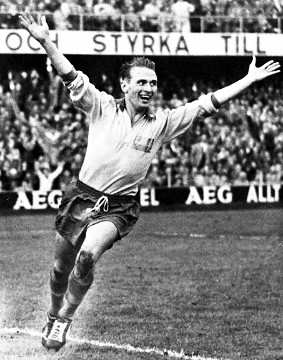
Second Italian Title and the 1970s
Many people did not expect Fiorentina to win the title in the 1968–69 season. Milan started as favourites, but Fiorentina slowly climbed to the top. The second half of the season was a close race between Milan, Gigi Riva's Cagliari, and Fiorentina. After Cagliari lost to Juventus, Fiorentina took the lead. The team then won all its remaining matches. They beat rivals Juve in Turin near the end of the season to win their second, and last, national title. In the European Cup the next year, Fiorentina played well. They even won in the Soviet Union against Dynamo Kyiv. But they were knocked out in the quarter-finals by Celtic.
The 1970s were not as successful for the Viola. After finishing fifth in 1971, they mostly stayed in the middle of the league table. They even came close to being relegated in 1972 and 1978. However, the Viola won the Anglo-Italian League Cup in 1974 and the Coppa Italia again in 1975. The team had young talents like Vincenzo Guerini and Giancarlo Antognoni. Antognoni later became a huge fan favourite. Because the players were so young, the team was called "Fiorentina Ye-Ye".
The Pontello and Cecchi Gori Eras
In 1980, Flavio Pontello bought Fiorentina. He changed the team's song and logo, which fans did not like. But he started to bring in top players. These included Francesco Graziani, Daniel Bertoni, and a young Roberto Baggio. The team was built around Giancarlo Antognoni. In 1982, Fiorentina had an exciting battle with rivals Juventus for the league title. After Antognoni got a bad injury, the title was decided on the last day. Fiorentina had a goal disallowed, and Juventus won the title with a disputed penalty. This made the rivalry between the two teams very strong.
The next years were mixed for Fiorentina. They sometimes finished high and sometimes fought to avoid relegation. They also bought interesting players like Ramón Díaz and, importantly, the young Roberto Baggio.
In 1990, Fiorentina almost got relegated. But they reached the UEFA Cup final, where they again played Juventus. Juventus won the trophy. Fiorentina fans were upset because the second game was played in Avellino, a city with many Juventus fans. Also, star player Roberto Baggio was sold to Juventus on the day of the final. Pontello faced money problems and had to sell the club after protests in Florence. The famous filmmaker Mario Cecchi Gori then bought the club.
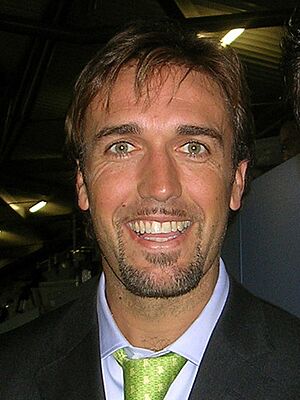
Under Cecchi Gori, the club started to sign good players. These included Brian Laudrup, Stefan Effenberg, and most importantly, Gabriel Batistuta. Batistuta became a legendary player for the team in the 1990s. In 1993, Cecchi Gori passed away, and his son, Vittorio, took over. Despite a good start, the coach was fired, and Fiorentina was relegated on the last day of the season.
Claudio Ranieri became the coach for the 1993–94 season. Fiorentina easily won Serie B, Italy's second division. Back in Serie A, Ranieri built a strong team around Batistuta. They signed young talent Rui Costa and Brazilian defender Márcio Santos. Rui Costa became a fan favourite. The Viola finished tenth that season.
The next season, Fiorentina bought more important players. They won the Coppa Italia against Atalanta and finished third in Serie A. In the summer, Fiorentina became the first team not to be national champions to win the Supercoppa Italiana. They beat Milan 2–1.
The 1996–97 season was not great in the league. But Fiorentina reached the Cup Winners' Cup semi-final. They lost to Barcelona, who went on to win the competition. After this season, Ranieri left, and Alberto Malesani became coach. Fiorentina played well but struggled against smaller teams. They still qualified for the UEFA Cup. Malesani left after one season, and Giovanni Trapattoni took over. With Trapattoni's guidance and Batistuta's goals, Fiorentina challenged for the title in 1998–99. They finished third, which qualified them for the Champions League. The next year was disappointing in Serie A. But the Viola played some memorable Champions League matches. They beat Arsenal 1–0 at the old Wembley Stadium and Manchester United 2–0 in Florence. They were knocked out in the second group stage.
At the end of the season, Trapattoni left. Turkish coach Fatih Terim replaced him. More importantly, Batistuta was sold to Roma. Fiorentina played well in 2000–01 and stayed in the top half of Serie A. They also won the Coppa Italia for the sixth and last time.
In 2001, it became clear that Fiorentina had huge money problems. They could not pay wages and had large debts. The club was relegated at the end of the 2001–02 season. In June 2002, the club had to restart due to financial issues. This meant the club could not play in Serie B for the 2002–03 season.
The Della Valle Era: From Lower Leagues to Europe
The club was quickly restarted in August 2002. It was named Associazione Calcio Fiorentina e Florentia Viola. Shoe and leather businessman Diego Della Valle became the new owner. The club was placed in Serie C2, the fourth tier of Italian football. Only one player, Angelo Di Livio, stayed with the club. His loyalty made him a fan favourite. With Di Livio and striker Christian Riganò, who scored 30 goals, the club easily won its Serie C2 group. This would normally lead to promotion to Serie C1. However, due to a special situation called the Caso Catania, the club skipped Serie C1. They were allowed to join Serie B. This happened because the Italian Football Federation (FIGC) decided to increase the number of teams in Serie B. They promoted Fiorentina for its "sports merits." In 2003, the club bought back the right to use the Fiorentina name and its famous purple shirt design. They officially became ACF Fiorentina again. The club finished sixth in the 2003–04 season. They won a playoff against Perugia to return to Italy's top league.
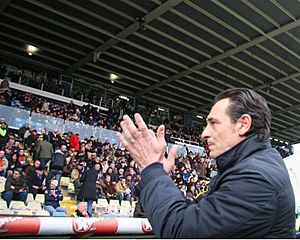
In their first season back in Serie A, the club struggled. They only avoided relegation on the last day. In 2005, Della Valle appointed Pantaleo Corvino as the new sports director. Then, Cesare Prandelli became head coach in the next season. The club signed several new players, including Luca Toni and Sébastien Frey. This helped them finish fourth with 74 points, earning a spot in the Champions League qualifying round. Toni scored 31 goals, the first player to score over 30 goals since 1959. He won the European Golden Boot for this. On 14 July 2006, Fiorentina was moved to Serie B. This was because of their involvement in the Calciopoli scandal, a football investigation. They also received a 12-point penalty. The team was put back in Serie A after an appeal. But they started the 2006–07 season with a 19-point penalty. Their Champions League spot was also taken away. Later, the penalty was reduced to 15 points. Despite this, they managed to get a spot in the UEFA Cup.
Even after Toni left for Bayern Munich, Fiorentina started the 2007–08 season strongly. Many thought they could challenge for the title. They qualified for the Champions League. In Europe, the club reached the semi-final of the UEFA Cup. They lost to Rangers on penalties. The 2008–09 season continued this success. A fourth-place finish secured Fiorentina's spot in the 2010 Champions League playoffs. Their European journey was similar to the previous year. They were moved to the 2008–09 UEFA Cup and were eliminated by Ajax.
In the 2009–10 season, Fiorentina started well in Italy. But they lost momentum and slipped to mid-table. In Europe, the team was a surprise. After losing their first away game, they won five matches in a row. This included beating Liverpool both at home and away. The Viola won their group. But they lost to Bayern Munich because of the away goals rule. This was controversial because of a referee's mistake. Bayern eventually reached the final. Despite a good European run and reaching the Coppa Italia semi-finals, Fiorentina did not qualify for Europe.
On 24 September 2009, Andrea Della Valle stepped down as chairman. Mario Cognini took over temporarily.
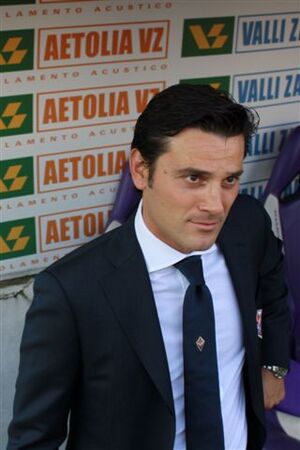
In June 2010, the Viola said goodbye to long-time manager Cesare Prandelli. He was the longest-serving coach in the team's history and left to coach the Italy national team. Siniša Mihajlović became the new coach. The club spent much of the 2010–11 season in last place. But their form improved, and Fiorentina finished ninth. After a loss in November 2011, Mihajlović was fired. Delio Rossi replaced him. After a short improvement, the Viola were again fighting relegation. Sporting Director Pantaleo Corvino was fired in early 2012. During a home game, manager Rossi physically reacted to a player, which led to his dismissal. Caretaker manager Vincenzo Guerini then guided the team away from the relegation zone. They finished 13th.
To improve the club after a tough season, the Della Valle family invested a lot in 2012. They bought 17 new players and appointed Vincenzo Montella as head coach. The team started the season well. They finished the 2012–13 season in fourth place. This was enough for a spot in the 2013–14 Europa League.
The club sold fan favourite Stevan Jovetić to Manchester City in 2013. They also sold Adem Ljajić and Alessio Cerci. They used this money to bring in players like Mario Gómez, Josip Iličić, and Ante Rebić. Fiorentina won their Europa League group. They beat Danish side Esbjerg fB. But in the next round, they lost to Italian rivals Juventus. At the end of the season, the team finished fourth in the league again. They also finished as Coppa Italia runners-up, losing to Napoli in the final.
In 2014–15, the team sold star winger Juan Cuadrado to Chelsea. But they got Mohamed Salah on loan, who played very well. Their 2014–15 Europa League campaign saw them reach the semi-finals. They were knocked out by Spanish side Sevilla, who won the competition. In the 2014–15 domestic season, Fiorentina again finished fourth. This qualified them for the 2015–16 Europa League. In June 2015, Vincenzo Montella was fired as manager. Paulo Sousa replaced him. He stayed until June 2017, when Stefano Pioli was appointed. Club captain Davide Astori sadly passed away at age 31 in March 2018. He had a heart attack before an away game. The club then retired Astori's jersey number, 13, in his honour. Fiorentina struggled in the 2018–19 Serie A season. They ended with a 14-match winless streak, finishing 16th. On 9 April 2019, Pioli resigned. Montella replaced him.
The Commisso Era (2019–Present)
On 6 June 2019, Italian-American billionaire Rocco Commisso bought the club for about 160 million euros. This ended the Della Valle family's seventeen-year ownership. Vincenzo Montella stayed as coach for the new era. However, Fiorentina continued to struggle. Montella was fired on 21 December after a 7-match winless run. Giuseppe Iachini replaced him. In November 2020, Cesare Prandelli returned to Fiorentina, replacing Giuseppe Iachini.
Under coach Vincenzo Italiano, who joined in 2021, Fiorentina reached and lost two finals in a row of the UEFA Europa Conference League. These were in the 2022–23 and 2023–24 seasons. They are the first club to reach two consecutive finals in this competition's history. They also became the first team to lose two consecutive European finals since Benfica in 2013 and 2014.
Players
Current squad
|
|
Fiorentina Primavera
|
|
Other players under contract
|
|
Out on loan
|
|
Notable Players and Retired Numbers
- 13
 Davide Astori, defender (2015–18) – This number was retired to honour Davide Astori after he passed away.
Davide Astori, defender (2015–18) – This number was retired to honour Davide Astori after he passed away.
Management Staff
Team Colours and Badge
Club Badge
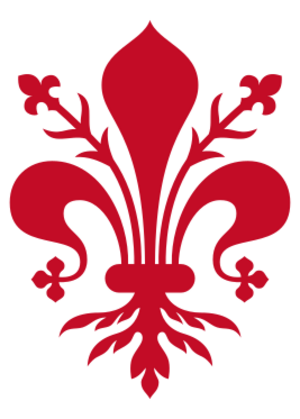
The official symbol of the city of Florence is a red fleur-de-lis on a white background. This symbol has always been a key part of the club's identity.
Over the years, the club's badge has changed several times. But all versions have included Florence's fleur-de-lis. The first badge was simply the city's coat of arms. It was a white shield with the red fleur-de-lis inside. Later, a more stylish fleur-de-lis was used. The most common symbol for about 20 years was a white diamond shape with the flower inside. When they won the Italian championship, the flower was placed over the scudetto (championship shield).
In 1980, a new logo was introduced. It combined half of Florence's emblem with half of the letter "F" for Fiorentina. Fans did not like it much. They thought it looked more like a spear than a fleur-de-lis.
Until the 2022–23 season, the logo was a kite-shaped double diamond with a gold border. The outer diamond was purple with white "AC" and red "F" letters. These letters stood for the club's name. The inner diamond was white with a gold border and the red Giglio (lily) of Florence. This logo was used from 1992 to 2002. After the club restarted in 2002, they could not use the same logo right away. Florence's city council allowed them to use a simpler city symbol. The current logo was bought back by Diego Della Valle the next year. It was the most expensive logo in Italian football at the time.
Team Kit and Colours
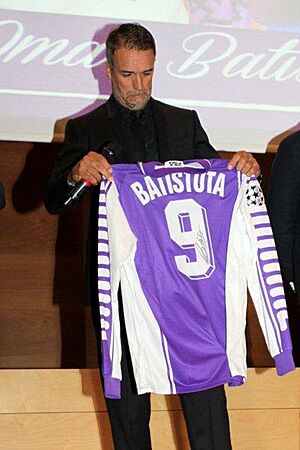
When Fiorentina was founded in 1926, the players wore red and white shirts. These colours came from the city's emblem. The famous purple kit was adopted in 1928 and has been used ever since. This is why the team is nicknamed La Viola ("The Purple team"). It is said that Fiorentina got their purple kit by accident. Their old red and white kits were washed in the river, and the colours mixed to create purple.
The away kit has usually been white. Sometimes it has purple and red parts. In the 1995–96 season, it was all red with purple edges and two lilies on the shoulders. The red shirt has been the most common third shirt for Fiorentina. They have also worn yellow shirts in some seasons.
For the 2017–18 season, the club used five different kits. There was one home kit (all purple) and four away kits. Each away kit represented a historic neighbourhood of Florence: blue (Santa Croce), white (Santo Spirito), green (San Giovanni), and red (Santa Maria Novella).
Club Anthem
"Canzone Viola" (Purple Song), also known as "Oh Fiorentina," is Fiorentina's official song. It is the oldest official football anthem in Italy and one of the oldest in the world. It was written in 1930, just four years after the club was created. A 12-year-old boy named Enzo Marcacci wrote the lyrics. Maestro Marco Vinicio arranged the music. The song became popular quickly.
The song was recorded by Narciso Parigi in 1959 and again in 1965. The 1965 version became the new Fiorentina anthem. Narciso Parigi later owned the rights to the song. In 2002, he gave the rights to a supporter club called Collettivo Autonomo Viola.
Kit Suppliers and Sponsors
| Period | Kit manufacturer | Shirt sponsor (front) | Shirt sponsor (secondary) | Shirt sponsor (back) | Shirt sponsor (sleeve) |
|---|---|---|---|---|---|
| 1978–1981 | Adidas | None | None | None | None |
| 1981–1983 | J.D. Farrow's | J.D. Farrow's | |||
| 1983–1986 | Ennerre | Opel | |||
| 1986–1988 | Crodino | ||||
| 1988–1989 | ABM | ||||
| 1989–1991 | La Nazione | ||||
| 1991–1992 | Lotto | Giocheria | |||
| 1992–1993 | 7 Up | ||||
| 1993–1994 | Uhlsport | ||||
| 1994–1995 | Sammontana | ||||
| 1995–1997 | Reebok | ||||
| 1997–1999 | Fila | Nintendo | |||
| 1999–2000 | Toyota | ||||
| 2000–2001 | Diadora | ||||
| 2001–2002 | Mizuno | ||||
| 2002–2003 | Garman / Puma | La Fondiaria / Fondiaria Sai | |||
| 2003–2004 | Adidas | Fondiaria Sai | |||
| 2004–2005 | Toyota | ||||
| 2005–2010 | Lotto | ||||
| 2010–2011 | Save the Children (Matchday 1–18) / Mazda (Matchday 19–38) | Save the Children (Matchday 19–38) | |||
| 2011–2012 | Mazda | Save the Children | |||
| 2012–2014 | Joma | ||||
| 2014–2015 | Save the Children | None | |||
| 2015–2016 | Le Coq Sportif | ||||
| 2016–2018 | Folletto / Vorwerk (Europa League) | Save the Children | |||
| 2018–2019 | Save the Children | Dream Loud Entertainment | New Generation Mobile | ||
| 2019–2020 | Mediacom | Val di Fassa / Meyer Children's Hospital | Prima Assicurazioni | Estra | |
| 2020–2022 | Kappa | None | |||
| 2022–2024 | Lamioni Holding | None | |||
| 2024– | Betway Scores |
Official Partners
- EA Sports – Football video gaming partner
- Montezemolo – Fashion partner
- Gruppoaf – Official partner
- Sammontana – Official ice cream
- Synlab – Health partner
- OlyBet.tv – Infotainment partner
Club Achievements
National Titles
- Serie A (Italian League):
- Winners (2): 1955–56; 1968–69
- Runners-up (5): 1956–57; 1957–58; 1958–59; 1959–60; 1981–82
- Coppa Italia (Italian Cup):
- Winners (6): 1939–40; 1960–61; 1965–66; 1974–75; 1995–96; 2000–01
- Runners-up (5): 1958, 1959–60, 1998–99, 2013–14, 2022–23
- Supercoppa Italiana (Italian Super Cup):
- Winners (1): 1996
- Runners-up (1): 2001
European Titles
- European Cup:
- Runners-up (1): 1956–57
- UEFA Cup Winners' Cup:
- Winners (1): 1960–61
- Runners-up (1): 1961–62
- UEFA Cup:
- Runners-up (1): 1989–90
- UEFA Conference League:
- Runners-up (2): 2022–23, 2023–24
Other Titles
- Serie B
- Winners (3): 1930–31, 1938–39, 1993–94
- Serie C2
- Winners (1): 2002–03
- Mitropa Cup
- Winners (1): 1966
- Anglo-Italian League Cup
- Winners (1): 1975
- Grasshoppers Cup
- Winners (1): 1952-57
League History
| Series | Years | Last | Promotions | Relegations |
|---|---|---|---|---|
| A | 85 | 2023–24 | – | |
| B | 5 | 2003–04 | Restarted due to financial issues | |
| C | 1 | 2002–03 | never | |
| 91 years of professional football in Italy since 1929 | ||||
Images for kids
See also
 In Spanish: ACF Fiorentina para niños
In Spanish: ACF Fiorentina para niños


